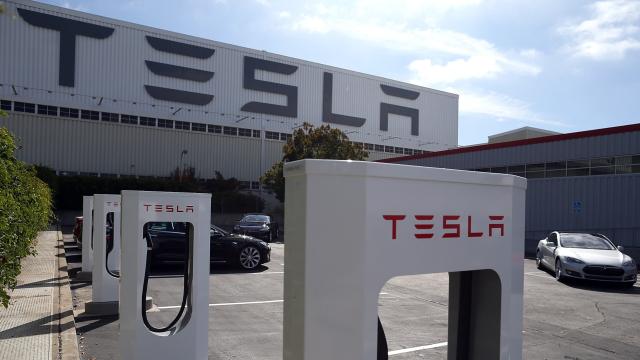It was June 29, 2010, when Tesla had its initial public offering. Shares now priced at more than $US800 ($1,226) could have been had for $US17 ($26), at first. The models X, S, 3, and Y didn’t exist. The future was uncertain.
For a good sense of what Tesla was, take these two grafs from a contemporaneous Wired story:
Tesla made its name selling the $US109,000 ($167,040) Roadster sports car, but its future depends on broadening its appeal with the Model S. The company plans to produce 20,000 Model S sedans annually. More than 2,200 people have placed deposits for the car, which will cost $US49,500 ($75,857) after the $US7,500 ($11,494) federal tax credit.
Musk, in an interview with CNBC, said “people need to appreciate that if we were just making the Roadster, we would be profitable as a company but we are in massive expansion mode. We are increasing our volume by 30 to 40 fold, so it is just impossible for a company to be profitable given that level of growth.”
Fast forward to now and those sentences are largely still true, even if the specifics have changed. The Tesla Model 3 has been a massive success, but the company is still in expansion mode, especially in China, with future profits uncertain and the coronavirus pandemic not helping.
Tesla posted profits of $US16 ($25) million for the first quarter of 2020, though selling $US354 ($542) million in regulatory credits helped. Given that car sales are down, most people expect that profit to turn into a loss in the second quarter, but if Tesla somehow makes a profit again, there’s now talk, per The Wall Street Journal, of the company breaking into the S&P 500, the stock index widely considered to be the best measure of the American economy.
Doing so would legitimise the company to a certain degree, though Tesla so far hasn’t met the requirements for inclusion. One requirement, for example, is that a company’s most recent quarter must be profitable, a box Tesla can check for now. More difficult for the company is a requirement that it also must be profitable for the full 12 months prior, something Tesla hasn’t been able to do yet.
Still, it is sort of remarkable that Tesla has gotten this close, per the WSJ:
On its face, generating a profit in the April-to-June period might seem improbable, given Tesla’s lone U.S. car plant was idled for about half that time. Analysts surveyed by FactSet predict Tesla will report a loss of $US387 ($593) million after deliveries fall 31% from the first quarter to 67,000.
Tesla got close to meeting the S&P 500 profit requirement already with its first-quarter results, but it fell short of a cumulative four-quarter profit by about $US144 ($221) million, with a $US16 ($25) million profit that wasn’t enough to offset losses in the second quarter a year earlier. Its most recent quarter also must be profitable, along with other requirements, for the S&P 500 to consider adding the company. A spokesman for the index declined to comment on an individual company.
The WSJ also notes that Tesla is pretty shameless about doing whatever it can to show a profit.
Mr. Musk has a history of surprising Wall Street, sometimes by triggering accounting levers not linked directly to car sales. Tesla’s surprise profit in the first quarter, when analysts expected a loss, was aided by a surge in the sale of tax credits that helped offset the drag on vehicle sales from the coronavirus pandemic.
This quarter, Tesla has been pushing landlords for rent breaks that could bolster its bottom line. It also furloughed workers without pay, while also temporarily cutting salaries of others.
With work at Fremont now resuming, Tesla could enjoy about seven weeks of production as long as suppliers—some with their own plants shut by local restrictions—can deliver parts in time.
Even if Tesla misses out in the second quarter of this year, it could still have a big second half of the year, and get into the S&P 500 then. Which would mean that Tesla will have satisfied S&P’s requirements, even if, by other analysts’ measures, the company could still be unsustainable long-term.
Here’s Wall Street Journal blogger Charley Grant’s test, to take one example:
If Tesla makes real $ 4 quarters in a row (IE without resorting to accounting games and related BS) I will admit I’m wrong about this company. Until then, you’re stuck with me.
— Wash Your Hands Charley Grant (@CGrantWSJ) May 5, 2018
That is a harder test, to be sure, but if Tesla ever gets there it will have completed its years-long transition from being a startup, to making a product, to scaling up to mass-market size, to becoming a profitable company built to last. The Model 3’s success and the Shanghai factory coming online probably means Tesla is somewhere in between the third and fourth items in that progression, even as it tries to grow more.
Until that changes—and it may be some time, because the vast majority of startups never reach the “profitable, sustainable company” phase—the rest of us will still be stuck watching the same tired old arguments play out about this company. Still, I would hazard that even Elon Musk didn’t think Tesla would last this long when Tesla went public nearly 10 years ago. God, that feels simultaneously like yesterday and like a million years ago.
